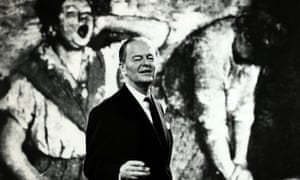
This autumn yet another new edition of EH Gombrich’s classic 1950 book The Story of Art – the “Luxury” edition – will be out in time for Christmas. Meanwhile the BBC is hard at work on Civilisations, an epic attempt to regain the factual television heights of Kenneth Clark’s 1969 series Civilisation.
Gombrich and Clark were outstanding scholars and thinkers in the academic discipline of art history, which means the historical study of the styles and meanings of art. They were also great public intellectuals who could share the subtleties of their knowledge in lucid prose with millions of people.
Today it would be very hard to find an academic historian in their league. The closest is probably the eloquent Marxist thinker TJ Clark, but even his brilliant ruminations on Picasso and the age of Auschwitz are far from mainstream fare. When I want a clear (and beautiful) explanation of what the Romanesque is and why it matters, I dig out my DVDs of Clark’s Civilisation for the hundredth time.
What killed art history? It is worth asking this as the last exam board to offer art history as an A-level gives up the ghost. The AQA board will drop AS-levels in history of art after 2018.
Is that a tragedy? The historian and art critic Simon Schama tweeted that the destruction of this A-level is “a big dull axe wielded by cultural pigmies”. Yes, but before getting on too high a horse, it is worth knowing that, as Maev Kennedy reported, only a “handful” of state schools offered art history A-level. Behind that handful is the embarrassing fact that most students sitting it were at public schools. In 2014, art history was offered by just 17 state schools – and 90 fee-paying ones. A campaign called the Maintained Sector History of Art Project, launched with a lunch at Sotheby’s (where else?), sought to correct the situation by inviting comprehensive pupils to join classes at public schools, like Victorian urchins being given charity.
I have met students who did history of art A-level – at their fee-paying schools. Very confident it made them too. Far from a savage attack on the people’s art history, this is the end of one privilege of the public-school elite.
But then, art history at university level is itself a bit of a posh subject. I never knew of its existence while I was at school and it would have been unimaginable for a Welsh comprehensive pupil to apply for such an apparently decorative discipline. At Cambridge – where I read proper history instead – I sometimes ventured into the art history faculty library. It was gorgeous, like a gentleman’s club, with students kitted out like Sebastian Flyte (this was the 1980s, when everyone was intoxicated by the TV adaptation of Brideshead Revisited) seated in comfy armchairs, languidly leafing through books on the baroque.
More recently, the most famous graduate in art history from a British university has been the Duchess of Cambridge. This week she was photographed at theMauritshuis in Holland looking at Vermeer’s Girl With a Pearl Earring – while wearing a pearl earring! It’s good that her degree from St Andrews gave her that insight into the Dutch Golden Age.
Other art history graduates, whether they went to private or state schools, gravitate to Britain’s booming art market to work at Sotheby’s or London’s legion of commercial galleries. Some will become curators at museums, or teach and research art history themselves. What none seem able to do is to share their knowledge with the general public in the way Gombrich or Clark once did.
Art history has become an obscurantist, elitist subject. It is remarkable that while theoretical physicists are constantly communicating their latest whacky ideas in popular books or on TV, none of the readable popular books on art history you will find in shops are by academic art historians. They are more likely to be written by art critics such as Martin Gayford or Andrew Graham-Dixon. Why is this?
It is a perverse spasm that results from the (not entirely unjustified) perception of art history as a posh person’s leisure activity. In the 1980s, a generation of art historians styled themselves “new” and “radical” – just like literary critics at the time they embraced “French theory”. Ever since, art history at the research level has abandoned any idea of elucidating the story of art in a humane and cogent way. In other words, the drive to prove art history is neither posh nor soft has resulted in a dry Byzantine academicism that can’t communicate outside a secluded seminar.
On the one hand, art history produces the well-groomed salespeople who makeFrieze Masters go with a swing. On the other it creates tedious discourses of no interest to anyone, or deconstructs its own intellectual purpose.
Meanwhile, the hole in our culture that was once filled by the great art historians gets ever larger. Abolish the A-level? This entire subject needs a shake-up.
[Source:-The Guardian]
